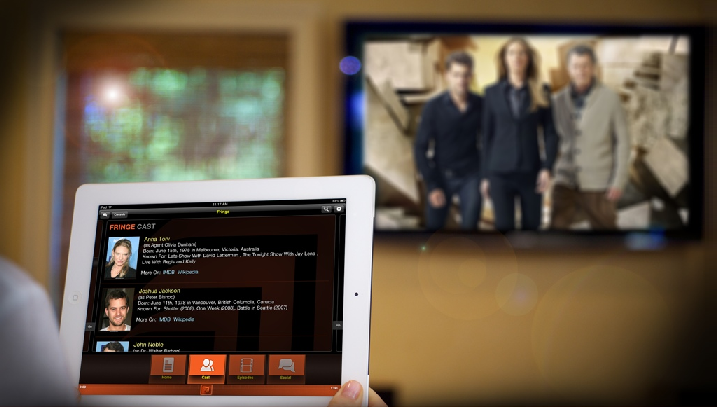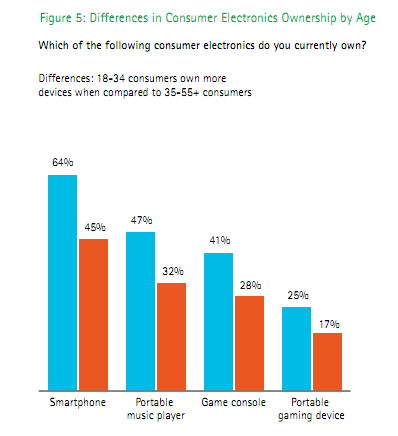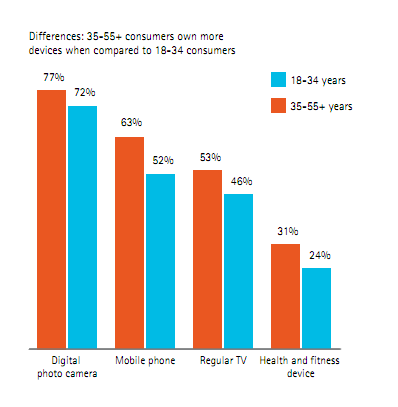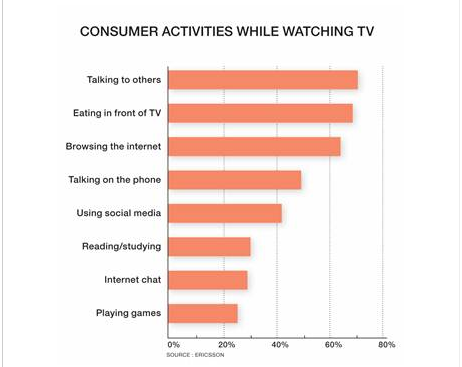REPORT: Consumers Shifting Further Away From Televisions
In a post last week, I wrote that for much of the U.S., the the large-screen HDTV is no longer the primary window to our digital world. More and more, consumers are choosing mobile devices and PCs as their preferred viewing device, compounding the problems the flat panel market is presently facing. Now a new report by Accenture lends further credence to this trend.
Their 2011 international survey found that the 18-34 age group is less likely to own a television than those aged 35-55+. Accordingly, the results show that a third of people now watch shows and movies on their PC and 10% on their tablet or smartphone in an average week. Another related and revealing statistic is that the percentage of consumers who regularly watch cable or traditional broadcast TV has declined by 23% since 2009.
There’s a few caveats to account for before attempting to parse out conclusions. First, the data does not identify the portion of the population who has their PC or mobile device connected to their television, which many do to enlarge the video size.1 Presumably, this portion is pooled together with the respective non-television categories. From a materiality standpoint, this might not affect the data too heavily, as this practice is mostly isolated to the tech savvy crowd. Few people on the street could even begin to explain to you what ‘HDMI mirroring’ is. Further, for many households, the PC is often prohibitively distant from the HDTV, disallowing this option.
Another, potentially more problematic, caveat here is that the survey makes no mention of the proportion of video consumed on various devices. Sure, 10% might watch a show or movie once a week on their mobile device, but how much do they watch on their large screen at home? I watch several shows a week on my smartphone but, proportionally, I watch quite a bit more on the plasma at home. Again, none of these options seem like mutually exclusive alternatives to me, but I’d like to know how well I correlate with the “average consumer.”
Lastly, the transition away from cable and broadcast programming does not necessarily imply that people are ditching their television, only altering the way content is delivered to it. It’s no secret that ever since Internet-sourced media came to the fore, cable and broadcast viewership has monotonically declined. Indeed, Accenture’s latest survey shows the largest movement yet in that direction. After all, most of the popular content formerly isolated to cable programming can now be found online using various streaming services. Roku, Boxee, Sony Netbox and Google TV devices and the Xbox 360 and PS3 game consoles are all equipped to push this content to your television. Many households may have simply swapped one set-top box for another. The report is absent on these alternative methods of video delivery. A statistic that distinguishes between the percentage of viewing per device might more precisely illustrate a shift away from television and toward more portable electronics.
With these cautions in tow, we can proceed to identify some industry signals reflected in the survey’s results. It’s self-evident that most people watching cable and broadcast (OTA) programming are doing so on a television. Equally evident is its deep correlation with age demographics. Sure enough, a quick glance at the chart below shows a greater percentage of smartphone ownership among the 18-34 crowd than the 35-55+ crowd. This tells us the baby boomer generation is traditionally more resistant to technological change, and thus cable and broadcast content on a television will likely continue to serve as their sole mechanism for media consumption.
But let’s examine the statistic that the 18-34 segment is less likely to own a television. As I discussed last week, online video consumption has skyrocketed the last two years, conveniently coinciding with the rising popularity of smartphones and tablets. Early on, the majority of smartphone traffic was short, 3 minutes or less, videos on YouTube or shared socially. Now, the presence of larger and higher quality screens has led to greater acceptance of watching movies and shows on mobile devices, something anathematized by purists and filmmakers just a couple years ago. Watching Avatar on an iPad is actually a very pleasant and enjoyable experience. Based on Accenture’s report, this practice is growing quickly and will continue to as the mobile market is further saturated.
Another statistic drives home this point. The survey also asked respondents whether they were likely to purchase an HDTV in 2012. Only 20% answered yes, down 5% from 2010. You could certainly attribute these numbers partly to market saturation or a faltering economy. It’s true a flat panel television is not replaced as swiftly as other, less expensive electronic products, and consumers may be currently more averse to discretionary spending. Yet the dominance of other devices in terms of video traffic cannot be understated. At least in much of the developed world, the HDTV is now supplementary to the PC, tablet and smartphone, as the findings here reveal a rapidly growing trend away from large-screen viewing. Just as the earlier generations have clung to the television and avoided forays into the mobile space, the later generations prefer mobile. As these diametrical generations shift proportionally, so will the trends.
TV No Longer a Group Experience?
While some may write these statistics off as nothing more than a natural trajectory of technological shifting, it seems to me these trends connote an underlying, more fundamental trend, one rooted in social signals. Since the inception of the television, watching TV has been almost exclusively a group or communal activity. The entertainment experience was traditionally enjoyed with friends and family. Today, watching TV is more of a solo activity. Day to day, how much content do you watch with other people compared with the amount you watch on a personal device, be it a laptop, smartphone or tablet?
Those devices are more popular choices not merely because they are more accessible and portable. They are also more functional and more personalized. Consider everything you can do on a phone or tablet that you cannot do on a television – browse the Internet, use social media, make voice calls, video chat, listen to music. If there’s an app for it, you can probably do it.
A study by Ericsson Consumer Lab, titled “TV & Video Consumer Trend Report 2011,” reported that consumers are already doing all of these things while watching TV. How much longer until we remove the HDTV from our digital carousel altogether? Social media in particular has greatly impacted the TV experience, with over 40% claiming to browse and update their social network feeds while watching TV.
HDTV manufacturers are trying to integrate many of these features into their sets by including social media apps and even internal web browsers. But it will take a few years for them to get it right, and by then it might be too late. Or it might not matter at all. Younger consumers find the laptop-smartphone combo plenty suitable. The only element absent is a large screen, but this is an acceptable trade-off for the functional, especially personal, value that more connected devices provide.
Consider this: it used to be enough to simply have a TV and a computer. Now everyone seems to have a computer, smartphone and, to a lesser but fractional extent, a tablet. The flat panel has seemingly been relegated to optional status. With all the electronic purchases one must make these days, will the television be left behind? Will consumers stop buying large-screen televisions for their living rooms and instead watch everything on laptops and mobile devices? The data from this survey clearly suggest this is already the case for younger demographics.
If we take the long view, then, it might indeed appear the flat panel market is irrevocably doomed. More and more of our life is spent online, and we expect our electronic devices to stay fully synchronized with our digital self. The ubiquity of social media and other popular Internet services have given rise to a more peripatetic, hyper-mobilized entertainment experience, where the ability to multi-task is of paramount importance. We expect to watch a show of our choosing, check our social media profile, and listen to a song, all from the same device. At present, PCs, smartphones and tablets bring us closer to this desired symbiosis than do HDTVs. While I’d like to believe there will always be a place for the television, it’s becoming clearer that tough times lie ahead for the industry.
More troubling, perhaps, is that this more personalized culture is also slowly de-emphasizing shared viewing. Will the entertainment experience one day be an entirely private affair?
Your thoughts? Are you starting to spend more time in front a mobile or laptop screen than a large screen HDTV? Do you frequently watch movies and shows on your tablet or smartphone? Do you agree or disagree that the community aspect of watching TV is slowly being lost? Let me know in the comments.
External Link: The 2012 Accenture Consumer Electronics Products and Services Usage Report
Feature image via 148apps.com
- Editor Note: Assuming your PC and TV are within close proximity, you can link the two with an HDMI cable (PCs) or a DisplayPort- or DVI-to-HDMI adapter (Macs). [↩]






Comments